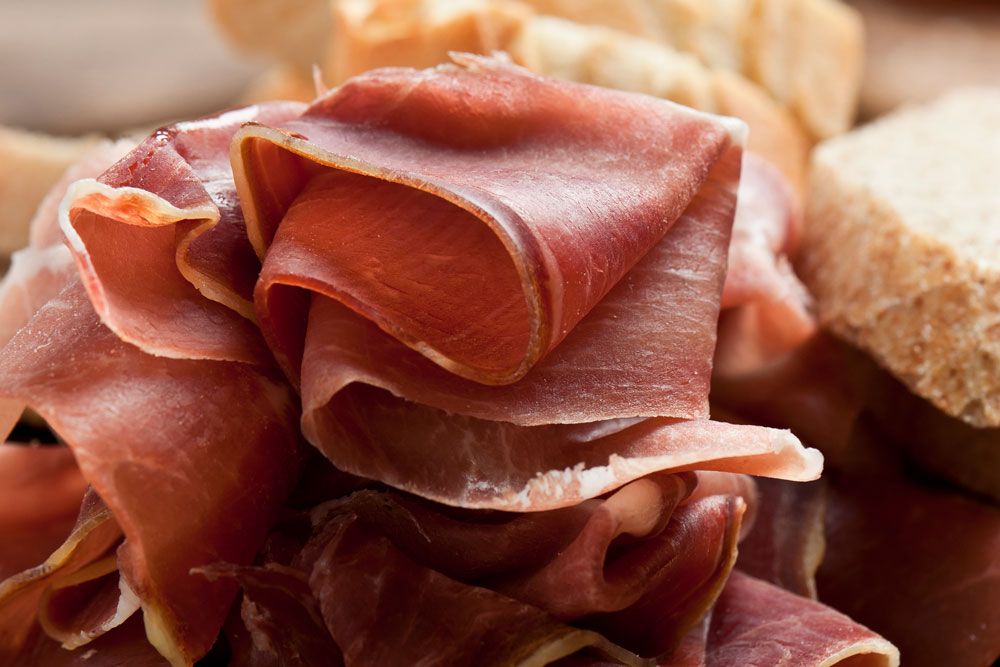By Tracy Morin
Everyone knows that pepperoni is the king of pizza toppings in the United States—though, in some regions, sausage takes the top slot (looking at you, Chicago!). Both of these options will likely always be mainstays of your menu. But that doesn’t mean you shouldn’t branch out into different pork toppings as a way to create unforgettable specialty pies that help you stand out from the competition. Here, pizza chefs around the country share how they’re using a variety of less-expected pork products with memorable (and profitable) results. Prepare to be inspired!

Photo courtesy Mercurio’s Artisan Gelato & Neapolitan Pizza
Anna Crucitt, owner, Mercurio’s Artisan Gelato & Neapolitan Pizza, Pittsburgh, PA
We try to keep a pretty traditional menu, but hopefully we can encourage some pizza makers to try something new. One of my favorite pies we make is called the Porchetta. We use a savory and fatty porchetta roast that has a garlic, rosemary and slight fennel flavor. It’s a white pie, with the porchetta laid on the crust; then we lightly cover it with a homemade burrata cheese. We add a little mascarpone to make it creamy and sprinkle with oregano before it goes in the oven. Once the pizza is cooked, we add crushed peppercorn and a drizzle of olive oil.
“One of my favorite pies we make is called the Porchetta. We use a savory and fatty porchetta roast that has a garlic, rosemary and slight fennel flavor.”
— Anna Crucitt, Mercurio’s Artisan Gelato & Neapolitan Pizza
We also use prosciutto cotto on our Romana pizza (with tomato sauce and our housemade mozzarella cheese) and inside of our calzone. We slice the meat a bit thicker than you would normally buy it, then chop it from there, so that the meat isn’t lost on the pie. I also think a thicker piece cooks better in the oven. For the Romana pizza, we write the description on the menu as “cooked Italian ham” to give our customers a better idea of what type of meat they’re getting. Our calzone has the prosciutto cotto, ricotta cheese, a little bit of tomato sauce, mozzarella and sauteed mushrooms. The cotto meat is perfect for cooking inside of the calzone.
Related: The possibilities of pepperoni: Pushing past the pizza pie
Getty Images
Extra Credit
Anna Crucitt, owner of Pittsburgh-based Mercurio’s Artisan Gelato & Neapolitan Pizza, shares some additional tips for working with—and marketing—lesser-known pork toppings:
Cooking and texture: We offer the option of adding prosciutto crudo to any pizza after it is cooked, but one of our best-selling pies is called the Pizza del Re, which is made with a mascarpone truffle spread, sauteed mushrooms and our housemade mozzarella. After the pizza is cooked, we lay the prosciutto crudo on top. Some of our guests ask us to cook the prosciutto on the pizza to give it a crispy texture, and we will do that for them, but I prefer the prosciutto to be soft with this pizza. We generally like to pair these soft meats with a softer cheese, like burrata, ricotta or mascarpone. I just like how the texture pairs with our crust.
Marketing and sales: We add pictures of these pizzas to our online menu, on Google, and on our social media so that customers can see what the pie looks like. A quality picture will help sell the pizza. Also, if you use a quality meat that has a lot of flavor, you don’t generally need a lot of it. Pairing a quality meat with a high-margin ingredient helps the overall profit margin. But people shouldn’t be afraid to charge what the ingredients are worth. If they’re in a market that isn’t as familiar with these types of pork, maybe try doing a special pizza, to start educating their customers. Once people try it, it’s what they’ll come back for!

Photo courtesy Lee Hunzinger
Lee Hunzinger, owner, PizzaLee33 Consulting, World Pizza Champions team member and Caputo Cup champion, Addison, TX
I like to use ’nduja, a spicy, spreadable pork sausage from the Calabria region in southern Italy. There are many ways to use or infuse it into any pizza, but I like to mix it with ricotta cheese—it lends an incredible smokiness. It will tint the color to beige, and the ricotta takes on an entirely different flavor. I also like to make jams/marmalades out of pork, which reimagines even traditional meats. Recently, at a trade show, I made some spicy pepperoni marmalade/jam. After making a classic New York-style white pizza, I added some of the jam post-bake. We do not want to “cook” the jam, which has sugar in it (as well as onions, garlic, roasted jalapeños, etc.) and could burn on a pizza with a longer bake. We received many compliments on this pizza over the three-day show!
Recipe: Crispy Pepperoni and Egg Breakfast Pizza

Pizza author Blaine Parker taps Creole and Cajun tastes by topping pizzas with pork toppings like andouille sausage and Tasso. Photo courtesy Blaine Parker
Blaine Parker, author, Free the Pizza!
For nontraditional pork toppings, one of my go-tos is smoked hog jowl. It’s the poor man’s guanciale. People always look at me like I’m crazy when I say this, but then they go and pay 30 times the price for imported guanciale. (The word “guanciale” literally translates as “jowl.” What more do you need to know?) Slice it thin, and it’s great. We also use andouille sausage, boudin and Tasso. We usually pair these with other Creole- or Cajun-friendly toppings. We like hot peppers, sometimes crawfish tails or shrimp, and fresh herbs and scallions as garnishes. The boudin is a head-turner when you put it on pizza with a vodka sauce and some fresh garlic.

At the eight-location Pupatella, the Ham & Mushroom combines prosciutto cotto, sautéed mushrooms and fresh mozzarella. Photo courtesy Pupatella
Enzo Algarme, co-founder, Pupatella (8 locations in Virginia and Washington, D.C.)
Pepperoni, sausage, bacon and ham are definitely the top meat options that Americans love, but in Italy, it’s all about cured meats and sausage. We’re an award-winning Neapolitan pizzeria (named in the “10 Best Pizza Places in the U.S.” by TODAY), and I personally love pizza with porchetta, brisket and even pulled pork. But you have to be really talented to pull it off, because these can often make the pizza too rich and heavy. You have to start with a well-executed product with great flavor and make sure to not overload the pizza. It’s also important to pair these toppings with something fresh and light, like balsamic glaze or fresh lemon or lime zest. Pickled red onions and/or pickled veggies can also be used to cut the grease of the meats, and a mild cheese is great to let the flavors of these unique meats really shine.
Tracy Morin is PMQ’s senior copy editor.
Getty Images
The Ever-Popular Pig
If you’re not already a dork for pork, here’s a quick rundown of some of the classic Italian meats.
Capicola and Coppa: These are very similar dry-cured meats that hail from different regions of Italy and are taken from the neck muscle of a pig. Sometimes sweet and sometimes spicy, they’re versatile and great with anything from salads to cheese plates to sandwiches. (As fans of The Sopranos may recall, capicola is sometimes pronounced “gabagool.”)
Lardo: Taken from the fatback of a pig and cured with herbs and spices, lardo has a rich, creamy, fatty flavor and pairs well with other bold flavors on pizza or bruschetta.
Mortadella: Ground pork is mixed with lardon, pepper and often pistachios to make this popular Italian sandwich meat. Some call it Italy’s version of bologna.
Pancetta: Like bacon, but cured and not smoked, pancetta is taken from pork belly, seasoned with salt and pepper, and hung to cure within a casing. Unlike prosciutto, which is often served uncooked, pancetta requires cooking. It’s great cubed and served over salads and pastas and in soups.
Prosciutto: Taken from the hind leg of a pig (sometimes boar), prosciutto is dry-cured and can be served cooked (cotto) or uncooked (crudo). Due to its traditional Italian flavor, many restaurateurs recommend prosciutto di Parma for use on meat and cheese plates and as a pizza topping. Prosciutto di San Daniele is another favorite that’s a little sweeter and darker in color.
Sopressata: Made from pork that’s ground into sausage, the flavor of this dry-cured meat—hot or not—depends on where it originated in Italy.















